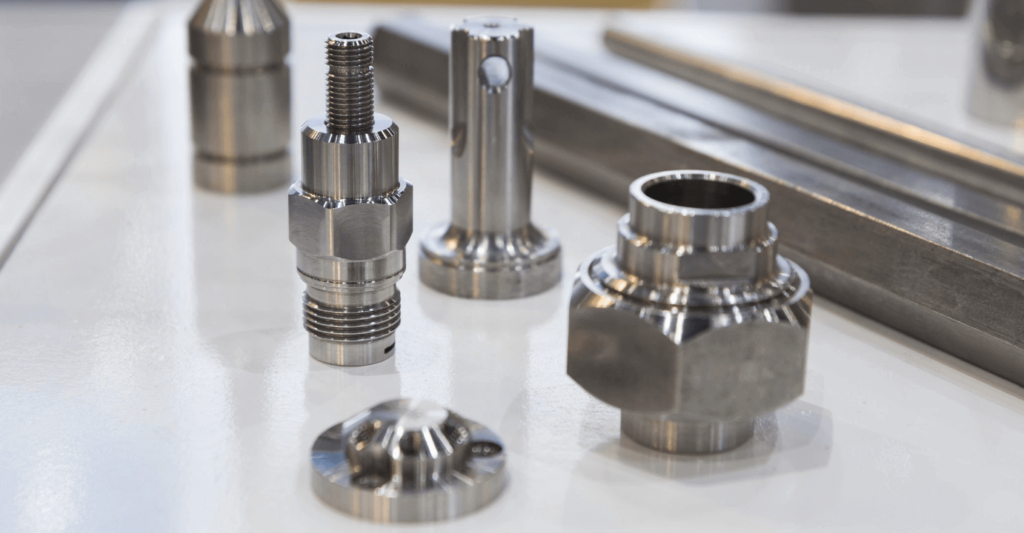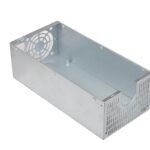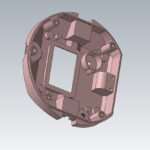What are Rivets Exactly?
Technically, a rivet can be called a permanent mechanical fastener or connector with a head at one end and a tail at the other end. The head of a rivet is smooth and the tail is cylindrical which resembles a metallic pin.
We are sure you must be aware of screws, bolts and nuts. These are commonly used in our homes to fasten or secure a home decor item. They are even used as connectors to join two pieces of wood or any other material. So, to put it simply, a rivet is a better version or a better replacement for screws, bolts, and nuts.
Rivets are permanent fasteners which means that once installed they cannot be removed or reused. Even if they are removed after being installed, they won’t be of any further use.

Installing Rivets
The installation process of rivets is fairly simple. A hole is punched or drilled onto the material that requires fastening. The rivet is then inserted and an impact is made on the smaller end to flatten the rivet and secure both the material and the rivet tightly together.
Riveted joints are very similar to bolted joints. There are basically two major types of joints used while installing rivets.
1) Lap Joints: In lap joints the two materials or components which are to be joined overlap each other. These joints are primarily used to join wood, plastic, or metal.
2) Butt Joints: In butt joints, there is no overlap but an extra material is used to join the two components. But joints are further classified into single strap butt and double strap butt based on the number of single plates used for joining the components.
The Riveting Process
While rivets are mechanical fasteners inserted through holes to join two parts together, the riveting process is a forging process through which the rivets join the two parts together. Both ends of the rivet consist of a permanently formed head which prevents the rivet from coming out and thus can securely join both parts.
During the installation process, the rivets undergo drilling or are punched into a hole. This causes the tail of the rivet to deform and also holds it in the desired place. The deformation of the tail makes the material flatter causing the tail to expand to a size about 1.5 times the original diameter of the stem. All of these mechanisms of rivets help to securely hold the material.
Material Used in Rivets
The rivets are mainly made up of steel, brass, aluminum, plastic, copper, etc. The choice of material depends on the desired usage. Any material that is used to make rivets must be tough and flexible. Ideally, the mechanical properties of the rivet should be similar to the components it is supposed to be fastening. Thus for example a plastic rivet is used to fasten soft materials.
Rivets made with different materials, have different properties and serve different purposes.
Steel Rivet: A steel rivet is tough and hence used in the aircraft, construction, and furniture industry.
Aluminum Rivet: An aluminum rivet is light in weight, corrosion-free, and durable. It is used in the aircraft, automotive, and air conditioning industries.
Brass Rivet: A brass rivet is tough and causes low friction making it an ideal rivet to be used in gas appliances.
Copper Rivet: A copper rivet is flexible, looks appealing, and is a good conductor of heat and electricity. These attributes of a copper rivet make it suitable to be used in electrical appliances.
High Carbon Steel Rivet: A rivet made with high carbon steel is hard, durable, and has a higher shelf life. It is used in the aircraft, automotive, and rail transport industries.
Plastic Rivet: Plastic rivets are soft and can be used to join soft and non-plastic materials such as rubbers. Plastic rivets are mainly used in consumer appliances and the construction and furniture industry.
Copper-Nickel Rivet: A rivet made with a combination of copper and nickel is highly resistant to corrosion and high temperature. This rivet is used in manufacturing ships and in making appliances, especially for places with corrosive environments.
Stainless Steel Rivet: A stainless steel rivet is strong, hard, and also corrosion-resistant. All these properties make it useful in the aircraft, automotive, and rail transport industries.
On top of the materials used to make rivets, these rivets often have an additional coating of a material such as zinc to increase the shelf-life, strength, and resistance of the rivets from wear and tear.
Application of Rivets
Rivets are ideal fasteners when it comes to supporting shear and tensile loads and they have a supreme fastening ability due to which they are ideal for heavy-duty applications and hence are being used in major industries, prominent being aircraft and textile industry.
Construction of Aircrafts
Heavy-duty materials are used in aircraft. These heavy-duty materials need to be well-fastened together or they may come apart and cause an accident. Rivets help to establish a strong bond between the various parts used in the construction of aircraft. Using rivets also helps in quick inspection and maintenance of the aircraft which saves both time and cost of repairs.
Construction of Buildings
Lots and lots of metal sheets are used in the construction of buildings. Rivets are used to hold these metal sheets strongly. Rivets are even used in the installation of doors, windows, and roofs in construction owing to their strength and durability.
Furniture Work
Rivets are the primary materials used in the furniture industry to manufacture sturdier and superior furniture items. Using rivets causes less wear and tear in the furniture items such as drawers, shelves, handles, etc.
Jewelry and Clothing
Both the jewelry and clothing industries have benefited immensely from the use of rivets. A major problem that both these industries faced was coming apart of two pieces of jewelry or cloth material for that matter. Rivets can clamp the two pieces of cloth together permanently and have brought a shift in which cloths and jewellery were made.
Electronics and Appliances
Rivets are resistant to heat, chemicals, and corrosion. These properties of rivets are used in electronic appliances to fasten plastic and rubber components used in them. Due to this even, the shelf life of the appliances is increased.
Advantages of Riveting
The benefits of riveting in the manufacturing world are enormous. Some of the major advantages of riveting are as follows:
Cost-Effective
Production of rivets is very cheap as compared to alternatives such as adhesives and welding. There is no electricity cost and riveting also brings down the number of other materials required for fastening to a great extent. The cost of transportation in the case of rivets is also comparatively small owing to their small size.
Durable
Rivets can withstand excessive vibrations and impacts. They are resistant to corrosion, moisture, fatigue, and even chemicals. The materials used in rivets make them tolerant to high pressures and load. Rivets are also tolerant to heating and cooling thereby minimizing the effect of temperature and heat on the joints. All these properties make the rivets durable and increase the life of the part being joined together.
Strong and Flexible
Rivets come in different shapes and structures. Irrespective of the size and structures one thing that is common in rivets is that they are strong and flexible. They can be used in different combinations to suit the requirement and can be used to make joints at any place and any location.
Wide range of applications
Rivets can not only join ferrous materials but also non-ferrous materials such as aluminum and copper. They can even join non-metallic materials such as wood and plastic. Moreover, rivets can even join to objects made with different materials.
Environment Friendly
With riveting, there is no question of fumes arising which happens during welding. So it is better for both the environment and the operator.
Easy Maintenance
When compared to alternatives such as wielding, the time, cost, and effort required to maintain a riveted joint is minimal. A worn-off wielding means one has to go with the installation process all over again. On the other hand, a damaged rivet can be very easily and quickly reinstalled using basic equipment such as a riveting machine or hammer.
Types of Rivets
Rivets come in various kinds of shapes and sizes to meet the various kinds of requirements. The different types of rivets are as follows:
1) Solid Rivets
Solid rivets are one of the simplest and reliable types of rivets. They are also the most commonly used ones. Sold rivets are made up of a solid shaft with a head at one end. After installation, the headless end is deformed to keep it secured in the applied place.
Solid rivets are available in round and 100° countersunk heads. Solid Rivets are most commonly used to make the frame of aircraft.
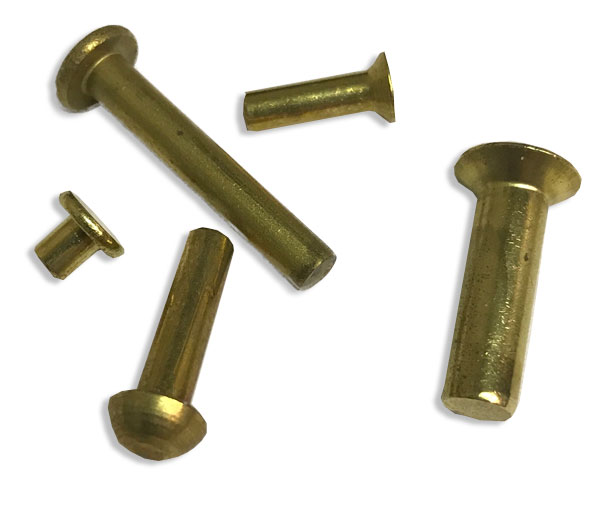
2) Blind Rivets
As the name suggests, Blind rivets can be installed completely from just one side. This property of blind rivets gives it several advantages such as that it can be installed by one operator without any help and the installation time is faster as compared to other types of rivets.
Blind rivets can be used to fasten metals, wood, and even plastics. They can even fasten two different materials together. For all these advantages blind rivets are majorly used in the manufacturing of boats, aircraft, and other vehicles.
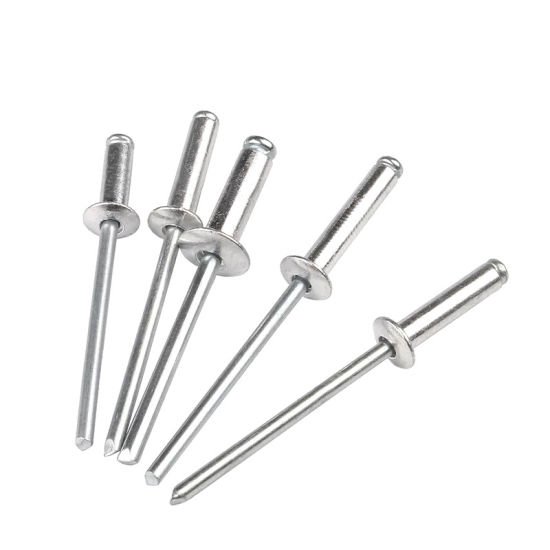
3) Split Rivets
Split rivets are commonly used to join softer materials such as wood, leather, and plastics. While using, split rivets are pre-split along the length of their shaft due to which two legs are formed.
Upon installation, these legs fold back which helps to hold the joined materials together. As they are used to join softer materials, split rivets are mainly used in the industries that produce clothes and plastics. Split rivets also find application in the households to carry out basic home-repair activities.
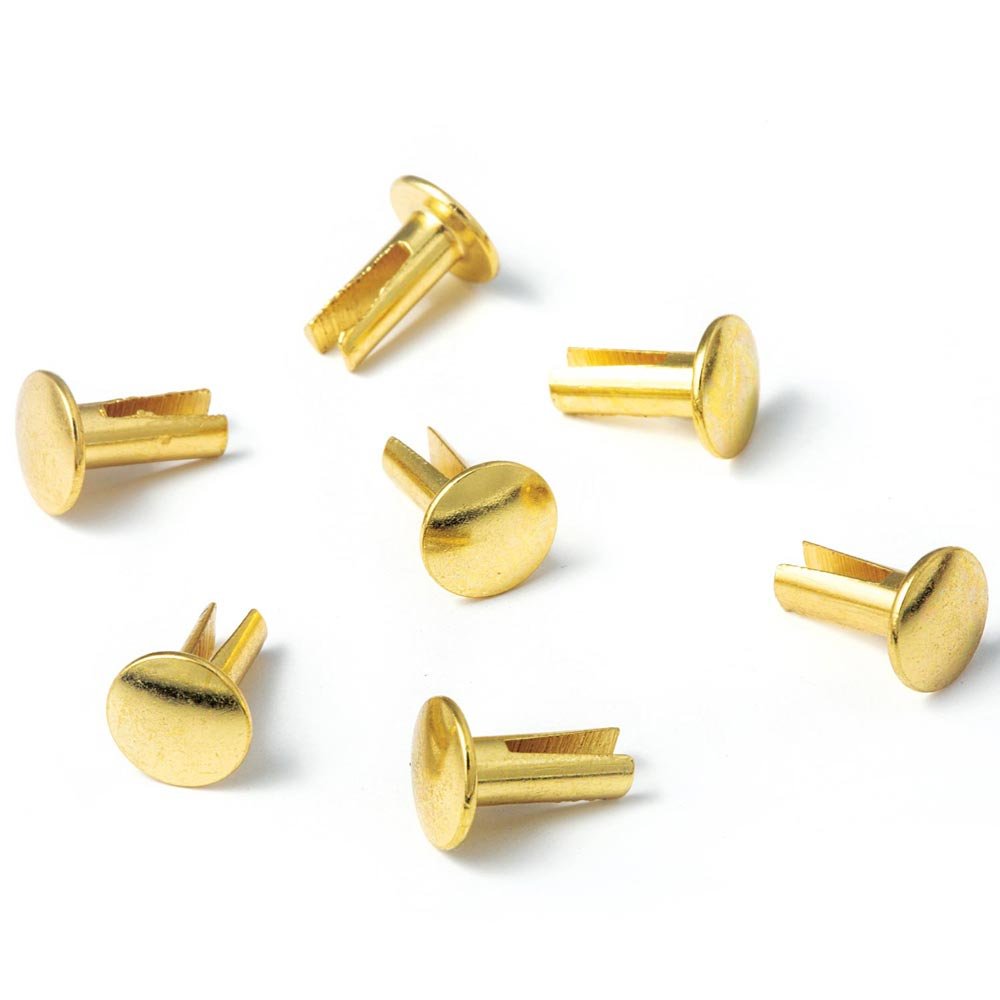
4) Drive Rivets
Drive rivets have a small protruding mandrel from the head. A major USP of drive rivets is that the holes do not require to be drilled all the way. Thus, they can be used with plastics, metals, and even other materials without a need to use specialized tools.
All one needs to do is drive the mandrel end of the drive rivets into the hole Installing a drive rivets requires very little force hence it is used in household works such as securing a nameplate.
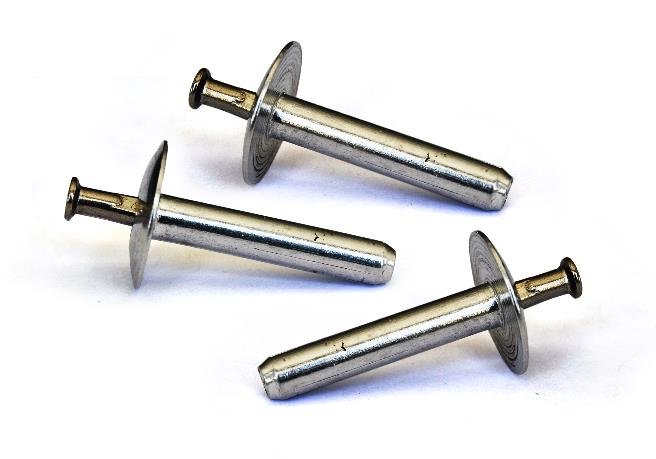
5) Tubular Rivets
Tubular rivets have a manufactured head on one end and the other end is hollow. Thus, these are partially hollow rivets and the hollow end requires cold forming. They find applications where the joints need to be movable.
Tubular Rivets are further classified into the following types:
- Compression Tubular Rivets: It consists of two parts, a stem and a cap that fit together. These are most commonly used in the clothing and textile industry for joining and fastening purposes.
- Semi-Tubular Rivets: Semi-tubular rivets are unique as they have a hole at the end of the shank. Installation of semi-tubular rivets requires a pre-drilled hole.
- Full Tubular Rivets: These have a deeper hole as compared to semi-tubular rivets and are majorly used to fasten hard and soft materials together. It is less damage-prone as compared to other rivets.
Tubular rivets are made with materials that are lower in strength and are majorly used for commercial purposes.
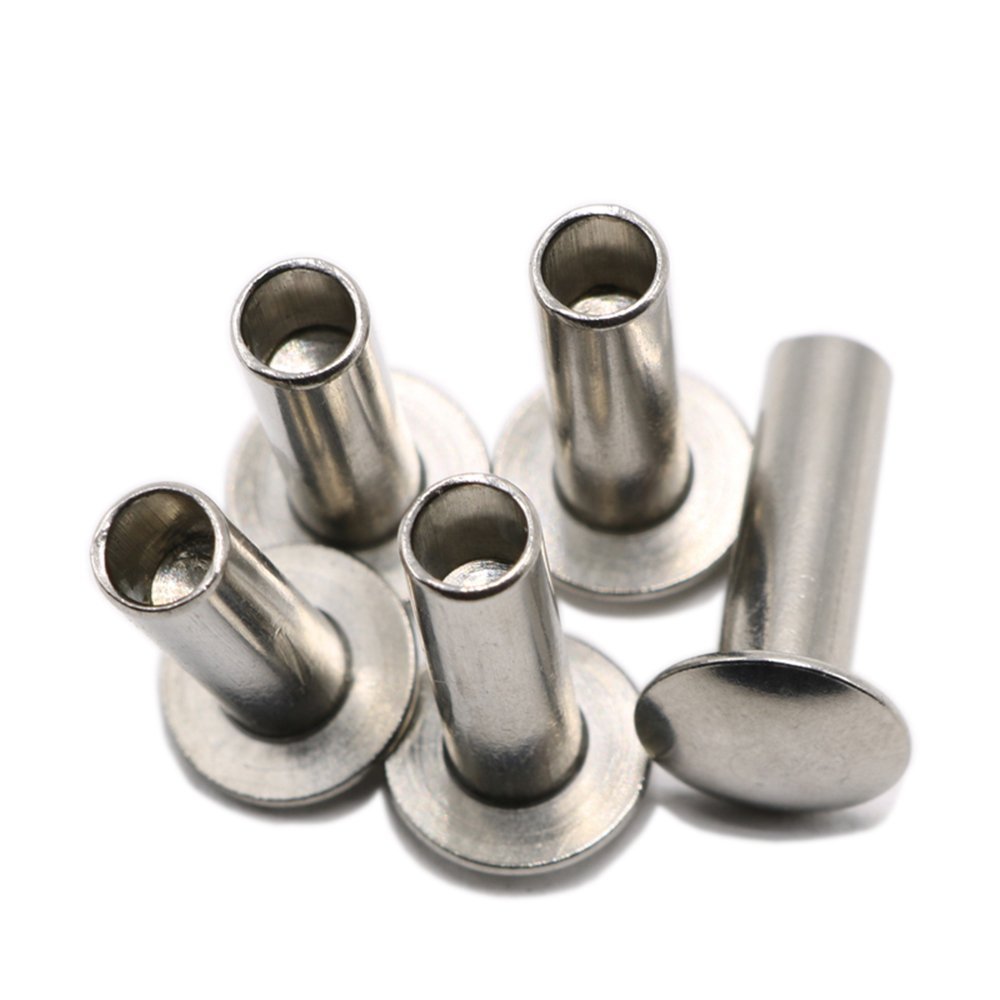
6) Threaded Rivets
The interior portion of a threaded rivet has a threaded stem while the external portion is machined flat on two sides. This feature allows the tool to grip and rotate it. The head is hexagonal which prevents the body from rotating while the mandrel bends and breaks off.
Threaded rivets can be installed in any material and are used when the installation is possible from only one side. Threaded rivets form a solid foundation to screw in bolts or other fasteners and thus these are ideal for mass installation purposes.
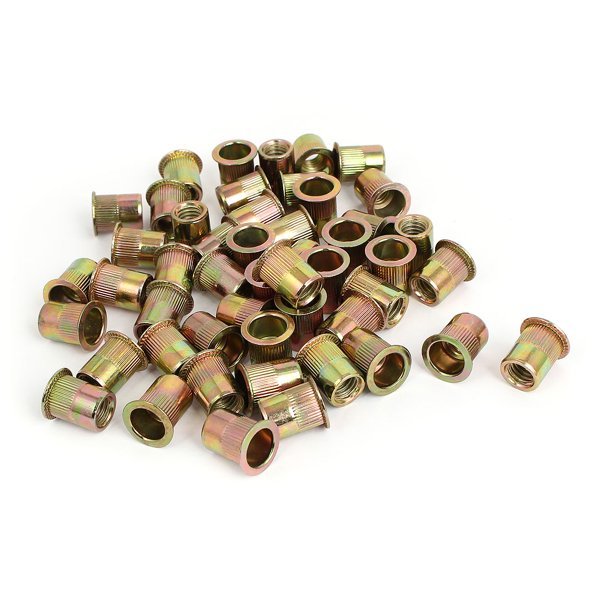
7) Oscar Rivet
Though oscar rivets appear very much like blind rivets, they are divided by a hollow shaft. In oscar rivets, the mandrel is pulled into the rivet which results in a split and causes the shaft to twist in and out. This property of oscar rivet minimizes the chances of wearing out. The unique design of the oscar rivet is ideal for high-vibration applications.
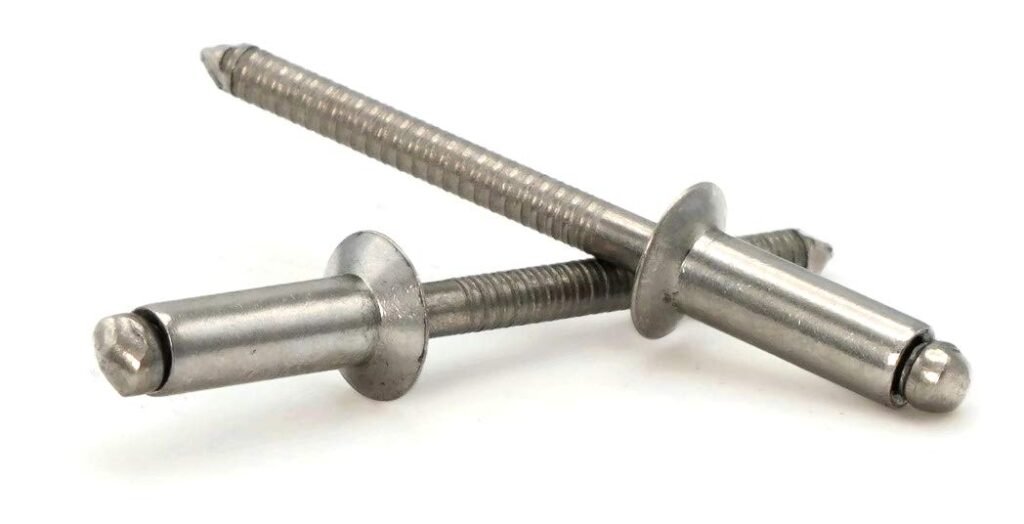
8) Flush Rivet
A flush rivet, also known as a countersunk rivet, is used primarily on external metal surfaces to make them appear good. The sleek and smooth design of the flush rivet makes it an ideal rivet that is extensively used in the manufacturing of aircraft.
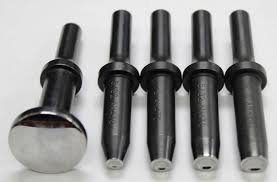
9) Friction-Lock Rivet
The blind end of a friction-lock rivet can be flush or dome-shaped. These are very much similar to expanding bolts, except that the shaft snaps below the surface when the tension is high enough. These are majorly used in the aerospace industry.
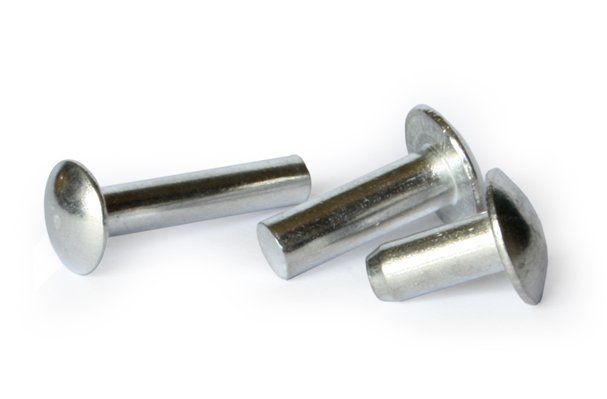
10) Self-Piercing Rivet
Compared to other rivets, self-piercing rivets do not require a drill or punch holes to be used. These are also semi-tubular in shape and have a partial hole at the opposite end of the head. The design includes a chamfered poke that helps this rivet in piercing the materials being joined.
While the self-pierce rivet can completely penetrate the top sheet material, it only partially penetrates the bottom sheet. As a result, a low-profile button is created when the rivet tail flares and gets interlocked into the bottom sheet under the influence of the upsetting die.
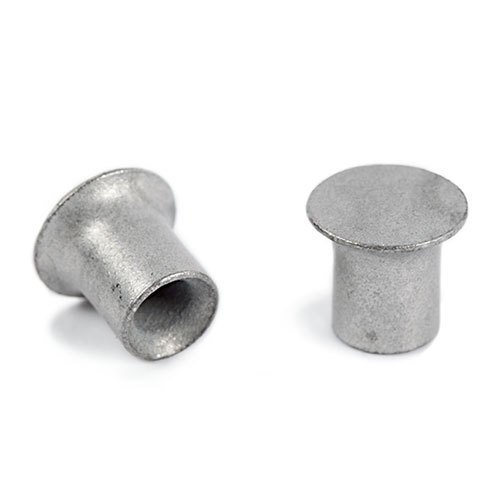
11) Pan Head Rivet
Uniquely designed, pan head rivets have a slightly rounded head sloping down from the top of the head. This helps them to provide a tighter grip during the fastening process. Pan-head rivets are used in heavy-duty based industry as they provide maximum strength and grip.
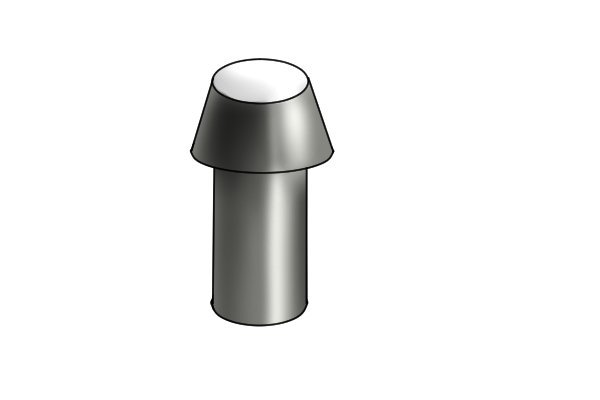
12) Mushroom Heat Rivet
As the name implies, they have heads like mushrooms. A mushroom head rivet is used to place the rivet head height on the metal surface which in turn provides the locking needed to hold the material strongly and securely.
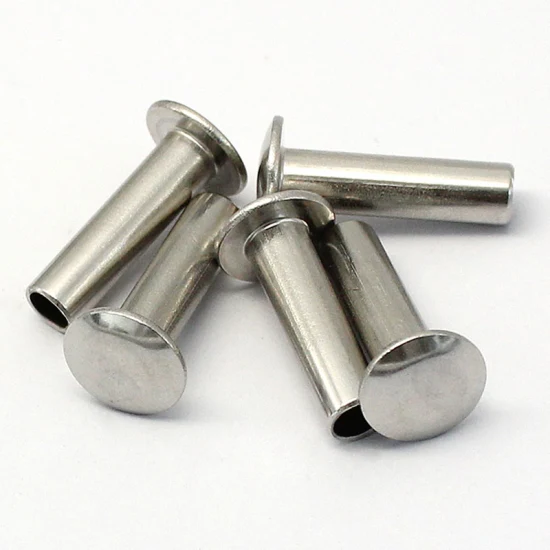
Thus, rivets are a widely used fastening material in the manufacturing world. Rivets are superior to other fastening materials such as nuts and bolts in terms of durability and flexibility. When compared with the welding process, the riveting process is cleaner, quicker, and a lot cheaper.
Rivets are versatile in the sense that they can fasten not only metals but also plastic. They can even fasten two different materials together. Today, rivets find application in various industries such as aerospace, construction, fashion, and others owing to their superlative features, it being cost and maintenance effective, and properties such as strength and durability.
Rivets come in different materials such as plastic, steel, copper, and also different types ranging from blind rivets to split rivets to cater to a wide range of industrial and manufacturing requirements. Using rivets also saves manufacturers the cost and effort in the maintenance of the materials. It can be concluded that rivets truly are the backbone of the manufacturing industry.

